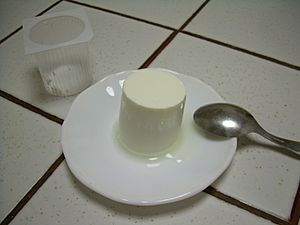Petit suisse facts for kids
Quick facts for kids Petit suisse |
|
|---|---|
 |
|
| Country of origin | France |
| Region, town | Normandy, Auvilliers |
| Source of milk | Cows |
| Pasteurised | Yes |
| Texture | Smooth, creamy |
| Aging time | ? |
| Certification | N/A |
Petit-suisse (pronounced "peh-tee sweess") is a special type of French cheese. Its name means "little Swiss cheese," but it actually comes from the Normandy region of France. It's known for being super smooth and creamy, almost like a very thick yogurt!
Contents
What is Petit-suisse?
Petit-suisse is a fromage frais, which means "fresh cheese" in French. Unlike many cheeses, it is not aged or ripened, and it doesn't have any salt added. This gives it a soft, creamy texture that many people love.
How Petit-suisse is Made
Petit-suisse is made from cow's milk. To make it extra creamy, extra cream is added to the milk. This makes the cheese very rich. After mixing, the cheese is smoothed out. Then, it goes into a special machine called a centrifuge. This machine spins the cheese very fast to remove extra water, making it thick and smooth.
Sizes and Packaging
You can usually find petit-suisse in small, cylinder-shaped packages. They typically weigh either 30 grams or 60 grams. The smaller ones are about 4 cm tall and 3 cm wide. The larger ones are around 5 cm tall and 4 cm wide.
How to Enjoy Petit-suisse
Petit-suisse is very versatile, meaning it can be eaten in many ways!
Sweet Treats
Many people enjoy petit-suisse as a dessert. You can eat it plain, or add a little sugar, jam, or honey to make it even sweeter. It's a delicious and healthy snack.
Savory Dishes
This cheese can also be used in savory (not sweet) dishes. It's sometimes mixed into meat stuffings to add moisture and flavor. Chefs even use a mix of petit-suisse and mustard on rabbit meat. This helps keep the meat from drying out while it cooks.
The Story of Petit-suisse
Even though its name suggests it's from Switzerland, petit-suisse actually has a French origin story!
A Swiss Idea in Normandy
The cheese was first made in the 1850s in Normandy, France. A Swiss worker at a dairy farm in a town called Auvilliers had a great idea. He suggested adding extra cream to the cheese curd. This made the cheese much richer and creamier than before.
From "Suisse" to "Petit-suisse"
When it was first sold, this cheese was simply called "suisse" (Swiss). It came in thin paper wrapping, packed six cheeses to a wooden box. Each cheese weighed 60 grams. Today, petit-suisse is made all over France. While the 60-gram size is still common, the term petit-suisse is often used for the smaller 30-gram cheeses. The larger 60-gram ones are sometimes called double petit-suisse, double suisse, or suisse double.
See also
 In Spanish: Petit-suisse para niños
In Spanish: Petit-suisse para niños

